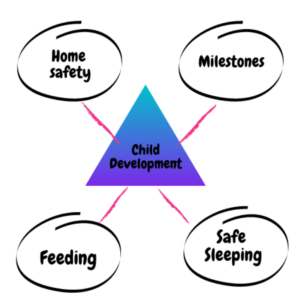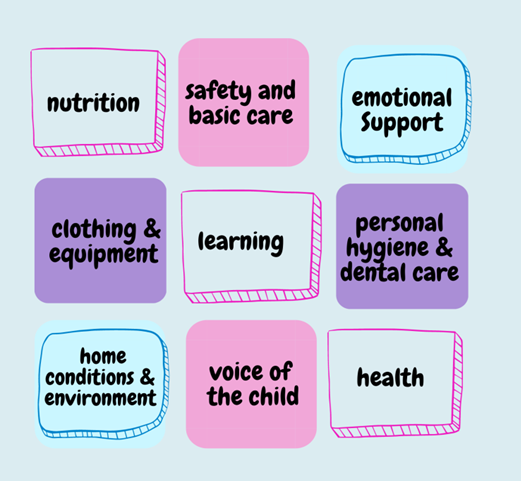Last Reviewed February 2025
One Minute Guide to Neglect & The Neglect Toolkit
What is Neglect?
'The persistent failure to meet a child’s basic physical and/or psychological needs, likely to result in the serious impairment of the child’s health or development' - Working Together to Safeguard Children, 2023
Neglect is the most common reason for a child to be on a child protection plan and features in 60% of serious case reviews / child safeguarding practice reviews.
-
Show details
 Understanding the impact of Neglect: Neglect has strong links with ACEs (Adverse Childhood Experiences). It occurs across childhood and adolescence but rarely produces a crisis response due to its cumulative nature. In childhood, neglect can seriously impede the brain, bodily functions, academic understanding and behavioural development, it can to lead to physical, emotional and health issues later in life.
Understanding the impact of Neglect: Neglect has strong links with ACEs (Adverse Childhood Experiences). It occurs across childhood and adolescence but rarely produces a crisis response due to its cumulative nature. In childhood, neglect can seriously impede the brain, bodily functions, academic understanding and behavioural development, it can to lead to physical, emotional and health issues later in life.Socio-emotional development can be impacted if a carer is emotionally disconnected with their child potentially leading to problems such as low self esteem and poor emotional regulation. As a result of these experiences poor social skills can develop which can lead to other compounding problems such as bullying.
-
Show details
Adolescent Neglect
Neglect is equally as damaging to an adolescent as it is to a young child.Young people who experience neglect only during adolescence display a range of negative outcomes at least as strong as those of children who experience neglect only during early childhood.
The range of the risk factors facing teenagers include, alienation from their families; school difficulties; accommodation problems; abuse/exploitation including grooming; unemployment; drug and alcohol misuse; emotional and mental health difficulties; and domestic abuse in the home.
-
Show details
 What can it look like? - Disorganised or insecure attachment of a child/young person, they may find caring and supportive relationships frightening or confusing.
What can it look like? - Disorganised or insecure attachment of a child/young person, they may find caring and supportive relationships frightening or confusing.
- Lack of parental response to a child’s health needs: e.g. untreated nappy rash, not registered with a dentist / doctor or missed routine appointments
- Lack of parental stimulation or interaction with child
- No parental concern over educational attainment / attendance at school
- Leaving children unsupervised or in an unsafe environment -
Show details
 Factors which can contribute to Neglect: - Parental alcohol/drug misuse
Factors which can contribute to Neglect: - Parental alcohol/drug misuse
- Postnatal, maternal and parental depression and other mental health issues
- Domestic abuse
- Lone parenting
- Blended families e.g. adolescents may struggle when a new partner is introduced
- Financial difficulties such as homelessness, poverty and unemployment
- Patterns of improvement in parental care, followed by deterioration
Impact of Cumulative Harm

-
Show details
Risk Factors
- Practitioners often react to risks that are immediate
- Signals which should alert Practitioners to dangers within families can be ignored due to optimistic assumptions
- Children in need, or children on the fringe of interventions are generally more at risk of serious harm than those on a child protection plan
- The impact of poverty creates an additional complexity alongside cumulative harm -
Show details
 What is the Multi-Agency Neglect Toolkit? Wakefield’s Neglect Toolkit supports practitioners to identify dangers in relation to neglect by providing a baseline to assess the context in which children and young people are living. It supports early identification of Neglect which is essential to ensure effective and prompt intervention to reduce impact and improve outcomes for children.
What is the Multi-Agency Neglect Toolkit? Wakefield’s Neglect Toolkit supports practitioners to identify dangers in relation to neglect by providing a baseline to assess the context in which children and young people are living. It supports early identification of Neglect which is essential to ensure effective and prompt intervention to reduce impact and improve outcomes for children.The Neglect Toolkit enables practitioners to understand how and when to take action, it assists in identifying emerging signs of Neglect and can be used to reduce the risk of drift and delay when responding to issues of neglect.
It should be used in conjunction with the West Yorkshire Multi-Agency Procedure Recognising Abuse & Neglect and the Wakefield Continuum of Need.
-
Show details
 More about the toolkit The Neglect Toolkit does not replace professional judgement, it aids clarification and supports decision making. Practitioners need to seek advice from their manager if concerns are identified and they are unsure of the action they should take.
More about the toolkit The Neglect Toolkit does not replace professional judgement, it aids clarification and supports decision making. Practitioners need to seek advice from their manager if concerns are identified and they are unsure of the action they should take.It is important that the focus remains on the child or young person; the voice of the child must always be sought and responded to. What do they think of their care, living conditions or their health and wellbeing? The application of the Toolkit should include holding an honest and respectful conversation with the parent(s) or carer(s) about any worries or concerns around Neglect.
The toolkit uses a scaling system throughout and has key indicators that support practitioners to identify if a child’s needs are being met or are unmet. It can form part of an assessment and in conjunction with the Continuum of Need, the toolkit identifies children where all needs are met right through to where there are serious and complex needs identified.
Important to note!
You may not always be able to fill in the whole document without working in partnership with other agencies.
Any information recorded is essential and will enable a holistic approach to assessment.

The 9 areas to consider
The toolkit has 9 sections and includes suggested questions to support the identification of adolescent neglect through the voice of a child.
Practitioners findings can be recorded on the Neglect Toolkit Assessment Form, this can then be printed and shared with the family and other professionals.

Supporting Documents
The documents below set out the strategic aims and objectives for tackling Neglect in the Wakefield District. They contain key principles under which the work around neglect should be undertaken and identify priority areas of work in order to improve Wakefield’s multi-agency response to child neglect.
- Using the Neglect Toolkit—How To presentation
- Neglect for professionals page
- Multi-agency online Neglect Toolkit
- Multi Agency Continuum of Need Updated Aug 2020
- Updated: Working Together to safeguard children: 2023 Statutory Guidance
Where can I get help?
For Early Help advice at all levels of need, contact your community cluster.
Early Intervention is Key
If you are concerned a situation requires an immediate response from Children’s Social Care contact the Integrated Front Door on 0345 8 503 503 or dial 999 in an emergency.
Useful Information
- WSCP Wakefield Safeguarding Children's Partnership website for further information and guidance and latest documents
- WFT Wakefield Families Together for more information and signposting to local services / groups.
- NSPCC Resources:· Safeguarding and child protection online training · weekly newsletter nspcc.org.uk/caspar Protecting children from neglect | NSPCC Learning


